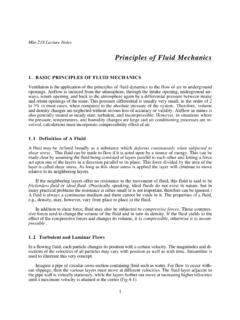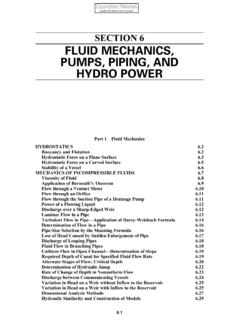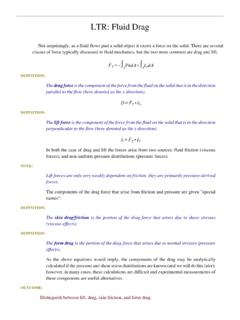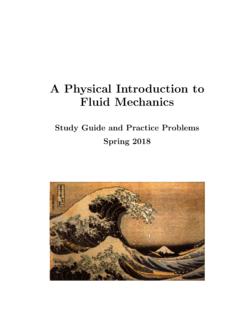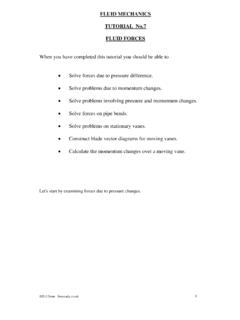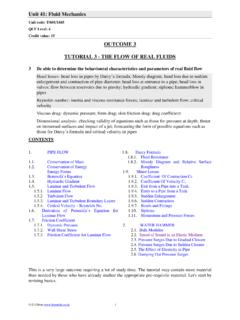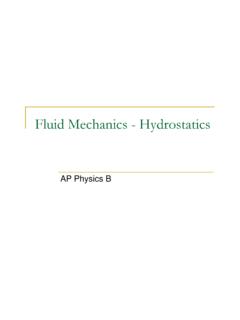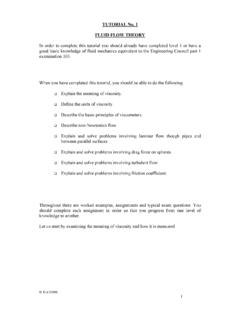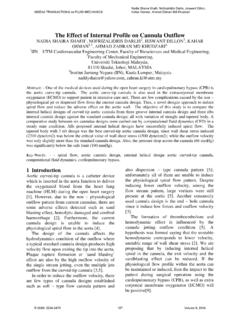Transcription of Darcy Friction Factor Formulae in Turbulent Pipe Flow
1 Darcy Friction Factor Formulae in TurbulentPipe FlowJukka Kiij arviLunowa fluid mechanics Paper 110727 July 29, 2011 AbstractThe Darcy Friction Factor in Turbulent pipe flow must be solvedfrom the Colebrook equation by iteration. Because of the iterationnew equations to solve this Friction Factor has been developed. Fromthese equations the Blasius, Swamee-Jain and Haaland equations werevalidated. All three equations can be used in a smooth pipe, butthe Swamee-Jain and Haaland equations are more accurate than theBlasius equation. The Blasius equation can t be used in a rough the Swamee-Jain and Haaland equation give good results in arough IntroductionPressure loss in steady pipe flow is calulated using the Darcy -Weisbach equa-tion. This equation includes the Darcy Friction Factor . The exact solution ofthe Darcy Friction Factor in Turbulent flow is got by looking at the Moodydiagram [5] or by solving it from the Colebrook equation [1].
2 If the Darcy Friction Factor must be known only once, the Moody diagramis good. This diagram is rather laborious to program in a computer code anddoesn t offer any the Colebrook equation must be solved by iteration. Al-though the solution is found usually with a few iterations, the iteration is forexample in large pipe flow computing codes time consuming and a possible Lunowa is a small company spezialized in technical consulting. Lunowa s web- source. The iteration needs the first guess of the value of the Darcyfriction Factor . How fast the iteration is, depends on how good the first the boundary layer can be thin in Turbulent pipe flow, the Darcyfriction Factor depends on the roughness of the pipe. The Colebrook equationhas a term for this order to avoid the iteration of the Darcy Friction Factor from the Cole-brook equation, new equations are deduced. In this study three equations toreplace the Colebrook equation are validated.
3 These three are the Blasius,Swamee-Jain [6] are Haaland [4] equation. The validation is limited only tosteady Turbulent pipe flow, in which the pipe is assumed to be circular. Thesolved Darcy Friction factors are compared to the solution of the this study the Darcy Friction Factor solved from an equation is calledaccording to the person or persons who has developed the equation. Forexample the Swamee-Jain Friction Factor means the Darcy Friction Factor ,which is solved from the Swamee-Jain Darcy -WeisbachThe pressure loss in pipe flow is calculated using the known Darcy -Weisbachequation. This equation is p=fLD V22(1)where ppressure lossfthe Darcy Friction factorLlength of pipe or pipe partDinner diameter of the pipe density of fluidVflow ColebrookThe Colebrook equation is the most widely used equation to solve the Darcyfriction Factor . The Colebrook equation is [1]1 f= log( + f)(2)2in whichfthe Darcy Friction factoreroughness of the pipeDinner diameter of the pipeRethe Reynolds numberThe ratioe/Dis called the relative roughness.
4 The Reynolds number iscalculated with the equationRe=V D (3)whereVis the flow velocity and the kinematic viscosity of the Reynolds number tells if the flow is laminar or Turbulent . If theReynolds number is smaller than the critical Reynolds numberRecr, theflow is laminar. After the laminar flow regime follows the transition the flow switches between laminar and Turbulent randomly. When theReynolds number reaches a certain value, the flow turns from transitionalto Turbulent . For pipe flow the critical Reynolds number is often assumedto be 2300. The transition region ends approximately at the Reynolds num-ber 4000 [2]. BlasiusThe Blasius equation is the most simple equation for solving the Darcy fric-tion Factor . Because the Blasius equation has no term for pipe roughness, itis valid only to smooth pipes. However, the Blasius equation is sometimesused in rough pipes because of its simplicity.
5 The Blasius equation is validup to the Reynolds number 105[3]. The Blasius equation isf= (4)wherefmeans the Darcy Friction Factor andRethe Reynolds Swamee-JainSwamee and Jain [6] have devoloped the following equation to the Darcyfriction factorf= [log( + )] 2(5)3in whichfthe Darcy Friction factoreroughness of the pipeDinner diameter of the pipeRethe Reynolds numberIn the Swamee-Jain equation the Darcy Friction Factor is solved directlywithout HaalandHaaland [4] has deduced the equation1f= log ( ) + (6)wherefthe Darcy Friction factoreroughness of the pipeDinner diameter of the pipeRethe Reynolds numberIn the Haaland equation there is no need to iterate the Darcy frictionfactor. The accuracy of the Darcy Friction Factor solved from this equationis claimed to be within about 2 %, if the Reynolds number is greater than3000 [3].3 CodeThe code for computing the Darcy Friction factors was written in Scilab scriptlanguage.
6 Scilab is a free softwarre for numerical computation. It is availablein the first guess of the Darcy Friction Factor in the Colebrook 2 equation isgot from the Haaland equation 6. The right side of the Colebrook equationis solved with this value. After that the new Friction Factor on the left sideis calculated. Now the right side of the Colebrook equation 2 is computedwith the new Darcy Friction Factor . Again the left side is solved and a newDarcy Friction Factor got. The loop is continued until the absolute differenceof the old and new Friction Factor is low 1: Computed diameter,eroughness,e/Drelative Initial valuesThe results were computed with three pipe inner diameters, which were , and mm. The pipe was assumed to be drawn tubing. Then theroughness of the pipe is mm [5]. Additionally the Darcy Friction factorwas computed to a smooth pipe in each diameter. The Reynolds number wasbetween 2300 100000 in these calculations.
7 The computed cases are given inthe table Smooth PipeIn the figure 1 are shown the absolute values of the Darcy Friction factorsolved from different equations. The pipe diameter is mm and relativeroughness 0. In one region the Darcy Friction Factor solved from Blasiusequation is a little higher than the other Friction factors . Otherwise thefriction factors are almost equal. Because the Friction Factor in a smoothpipe is only a function of the Reynolds number, the figures of diameters mm are the the same as with the diameter the figure 2 are given the relative errors of the Darcy Friction factorssolved by different Blasius Friction Factor has the greatest relative error at theReynolds number 2300. The Swamee-Jain Friction Factor has the relativeerror % and the Haaland Friction Factor at the same Reynolds num-ber. Then the Blasius Friction Factor has the greatest relative error up tothe Reynolds number about 85000.
8 The absolute value of the relative errorof the Blasius Friction Factor increases after the Reynolds number 100000, 1: The Darcy Friction factorfsolved from different equations as afunction of the Reynolds numberRe. Bla Blasius equation 4, Swa Swamee-Jain equation 5, Haa Haaland equation 6 and Col Colebrook equation mm,e= 0,e/D= 2: Relative errors f/fof the Darcy Friction Factor solved from differ-ent equations as a function of the Reynolds numberRe. Bla Blasius equation4, Swa Swamee-Jain equation 5 and Haa Haaland equation mm,e= 0,e/D= 3: The Darcy Friction factorfsolved from different equations as afunction of the Reynolds numberRe. Bla Blasius equation 4, Swa Swamee-Jain equation 5, Haa Haaland equation 6 and Col Colebrook equation mm,e= mm,e/D= it is not shown in the figure 2. The relative errors of the Swamee-Jainand Haaland Friction factors are approximately constant after the Reynoldsnumber 60000.
9 Then the relative error of the Swamee-Jain Friction Factor is % and of the Haaland Friction Factor Rough PipeThe Darcy Friction factors solved from different equations are shown in thefigures 3, 4 and 5. There can t be seen no significant difference in the frictionfactors solved from the Swamee-Jain, Haaland and Colebrook equation. TheBlasius Friction Factor differs from the others. When the relative roughnessgets smaller, the Blasius Friction Factor differs from the other Friction relative errors of the Darcy Friction factors solved from different equa-tions are given in the figures 6, 7 and the Reynolds number is 2300, the relative error gets smaller in everycase when the relative roughness decreases. The relative error of the Blasiusfriction Factor is usually the greatest. At the small Reynolds numbers, theerror of the Haaland Friction Factor is smaller than the error of the Swamee-Jain Friction Factor . Else the error of the Swamee-Jain Friction Factor isthe smallest.
10 When the pipe diameter is mm, the relative error of theSwamee-Jain Friction Factor is only % at the Reynolds number 4: The Darcy Friction factorfsolved from different equations as afunction of the Reynolds numberRe. Bla Blasius equation 4, Swa Swamee-Jain equation 5, Haa Haaland equation 6 and Col Colebrook equation mm,e= mm,e/D= 5: The Darcy Friction factorfsolved from different equations as afunction of the Reynolds numberRe. Bla Blasius equation 4, Swa Swamee-Jain equation 5, Haa Haaland equation 6 and Col Colebrook equation mm,e= mm,e/D= 6: The relative error f/fof the Darcy Friction Factor solved fromdifferent equations as a function of the Reynolds numberRe. Bla Blasiusequation 4, Swa Swamee-Jain equation 5, Haa Haaland equation 6 and ColColebrook equation mm,e= mm,e/D= 7: The relative error f/fof the Darcy Friction Factor solved fromdifferent equations as a function of the Reynolds numberRe.


